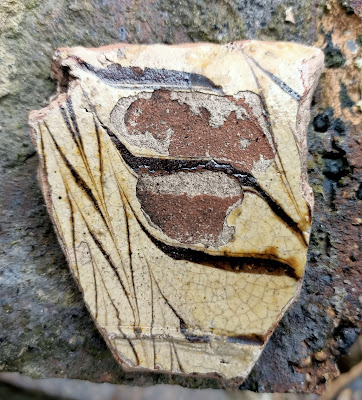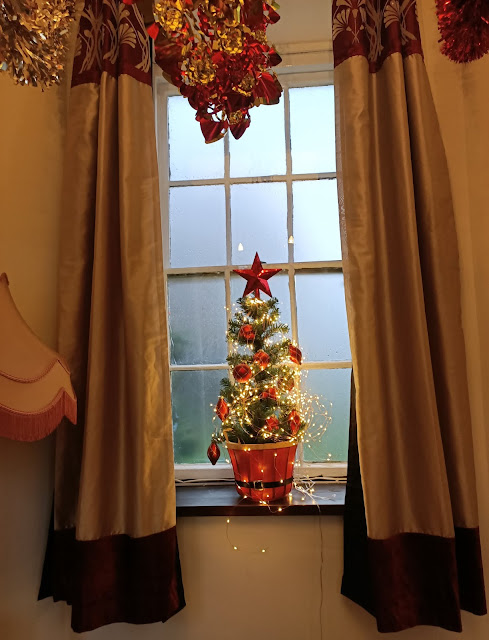Primulas and Pottery
It’s been a bit of a quiet week at Betley Court Gardens. The activity and hubbub surrounding the temporary roof construction is abating, and what is left of the house is drying out nicely. Nigel, his brother Martin and our eldest donned hard hats and hi-viz and went inside to take photographic records of some of the architectural details inside. The translucent skin has changed the atmosphere inside, but the occasional opportunist plant has started growing in Betley Court’s shell.
 |
| A view of the formal beds, from the heights of the scaffolding. |
 |
| A groundsell plant, squatting in the main hall |
Outside, the electric security gates we commissioned from Charis Jones back in 2016, have been reinstated. Nigel likes getting jobs like these sorted. Our specialist company, Sonitech, have made a few adjustments but the gates are working better than ever. It’s a welcome sign of life returning to how it was before the fire. The gates make life easier for those of us working there, and obviously help the three households that still inhabit Betley Court.
We’ve also planted primulas along the wall at the front of
the house, to make Betley Court look cared for after, as much as possible while
we rebuild. As I was weeding, I unearthed another pottery shard in the soil,
from my favourite period of local pottery, the late 18th early 19th
century slip-decorated ware.
 |
| The little shard, glaze side up |
Since the Potteries Museum & Art Gallery is not open, due to Covid lockdown, I consulted my favourite source for information on broken crockery – Julia Smith’s Mudlarking blog. Although she stopped writing the blog some years ago, it is still an excellent resource of photos of broken crockery she’s found on the banks of the Thames a low tide. The pieces are often identified and she usually adds a short history of the finds, so I owe her a big “thank you!” for the following info.
 |
| The unglazed underside |
My little shard was once part of a baking or loaf dish. It is unglazed on the outside and made from red clay. The inside surface that came in contact with food is glazed, and has been decorated with slip (watery clay that is brushed or dipped on the surface for decoration). On this shard, I can see that the decoration is marbled. This technique involved painting a base layer – creamy-yellow slip in this case, then applying thin contrasting stripes over the top in dark brown slip. While both slips are still wet, a point or comb is stroked across the surface. When dry, a transparent overglaze is applied on top, making the dish food-safe once fired. The best description of this decorative technique I came across is ‘Bakewell Tart’ decoration. The method is exactly the same, just using icing sugar glaze, rather than slip.
 |
| The shell edge, with the indented ribs of the shell still visible. Excuse the dirty finger nails. |
The other notable thing about my little shard is the edge of the dish. In the late 1700s, there was a fashion for what are described as ‘pie crust edge’. As it sounds, the edges were crimped or coggled during the making process, and resemble the edge of a pork pie crust. Later, (1780-90s) a shell edge became fashionable. This involved impressing either a finger nail-sized cockle shell, or a tool that made the same impression into the wet clay at neat, regular intervals along the edge. On my shard, the little ribs of the shell that was imprint are still visible.
 |
| This is similar to how the little shard might have looked. From the Victoria & Albert Museum |
Combware like this was made in the late 18th century, for poor and middle-class households, as well as taverns. Utiliarian, sturdy and practical. Although combware was made elsewhere, we’ve dug up several shards of slip-decorated ware from the Burslem town of the Potteries region in North Staffordshire – a mere 10 miles away. The Victoria & Albert Museum collection holds a very nice example they date from 1770-1830.
 |
| The growing shard collection |
I’ve been wondering about how this shard came to be buried
by the wall by the bus stop on Main Road. Anastasia, John Craddock IV’s
daughter returned to Betley Court after her father’s death in 1758. Her time at
Betley Court marks a period of expenditure and expansion on the house and
grounds, following a period of neglect (the family had rented out Betley Court
to Catherine and Charles Tollet, who did not look after the house well, apparently!).
Perhaps the dish was broken in this time? Most likely, it was just dropped in
one of those everyday mishaps, and the remnants tossed into the garden perhaps
240-odd years ago. The little shard will
join my other unearthed treasures, discovered as I dig the garden over.
All best wishes
Ladybird Su



Comments
Post a Comment